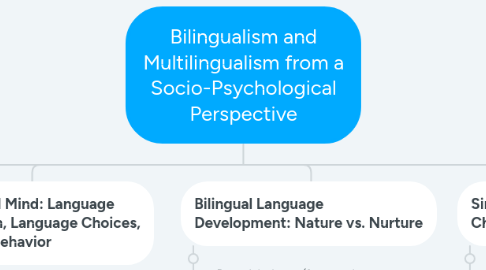
1. Understanding Multilingualism in Context
1.1. Coexistence of several languages in a country or territory.
2. Bilingualism as a Natural Global Phenomenon: Becoming Bilingual
2.1. Contrary to a widespread perception, particularly in some primarily monolingual countries—for instance, Japan or China—or native English-speaking countries, such as the United States, bilingualism or even multilingualism is not a rare or exceptional phenomenon in the modern world; it was and it is, in fact, more widespread and natural than monolingualism.
3. Describing Bilingualism
3.1. Bilingualism is a lifelong process involving a host of factors and different process, such as:
3.1.1. marriage, immigration, and education, input conditions, input types, input modalities and age.
3.1.1.1. yielding differential end results in terms of differential stages of fossilization and learning curve
3.2. Individual Bilingualism: A Profile
3.2.1. It is the person himself who has the ability to master both languages and who decides when to use one or the other interchangeably.
3.3. Social Bilingualism
3.3.1. That ability that a person acquires to communicate independently and alternately in two languages. It also refers to the existence of two languages in the same territory.
3.4. Political Bilingualism
3.4.1. Political bilingualism refers to the language policies of a country.
4. The Bilingual Mind: Language Organization, Language Choices, and Verbal Behavior
4.1. Bilingual Language Modes
4.1.1. Bilinguals are like a sliding switch who can move between one or more language states/modes as required for the production, comprehension, and processing of verbal messages in a most cost-effective and efficient way.
4.2. Bilingual Language Separation and Language Integration
4.2.1. activation or deactivation control phenomena, the other two salient characteristics of bilingual verbal behavior are bilinguals’ balanced competence and capacity to separate the two linguistic systems and to integrate them within a sentence or a speech event.
5. Bilingual Language Development: Nature vs. Nurture
5.1. Beyond the innate (for example, nature, the biolinguistic and neurological bases of language acquisition), social factors play a fundamental role in the language development of bilinguals.
6. Simultaneous vs. Sequential Childhood Bilingualism
6.1. childhood bilingualism can manifest itself in two distinct patterns:
6.1.1. Simultaneous bilingualism
6.1.2. Sequential bilingualism
